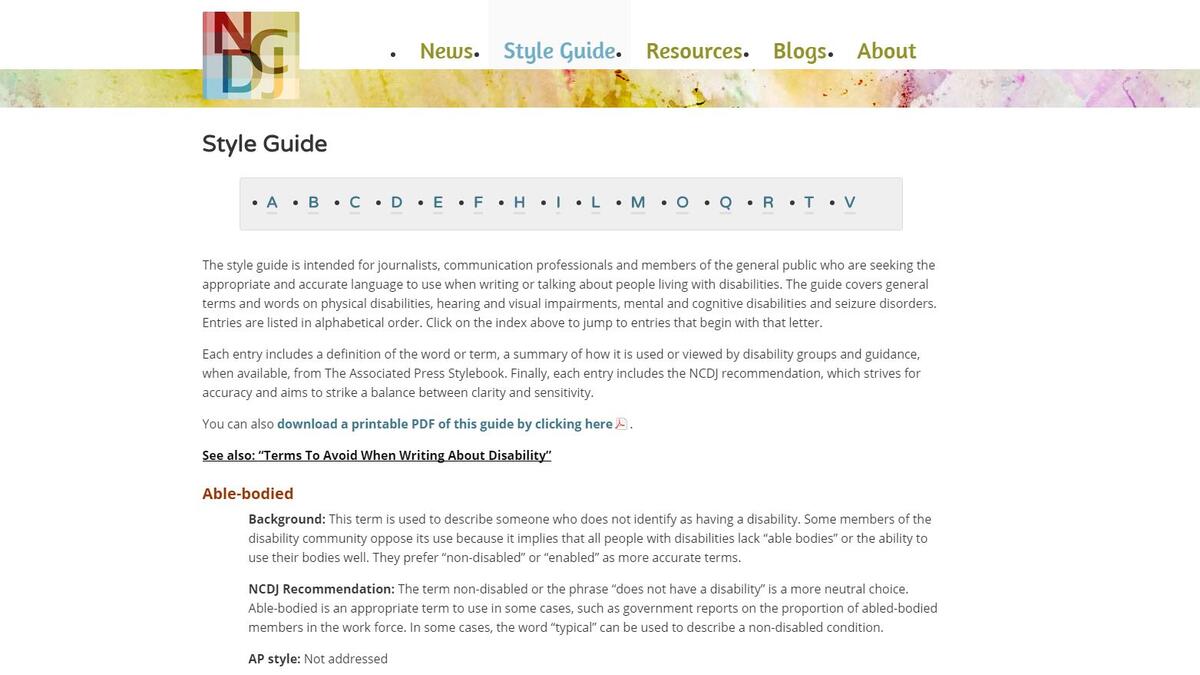ASU center releases new style guide on disabilities

The National Center on Disability and Journalism at ASU has released a style guide for journalists and professionals who report or write about people living with disabilities.
The National Center on Disability and Journalism (NCDJ) at Arizona State University has released a one-of-a-kind style guide for journalists and professionals who report or write about people living with disabilities.
The guide offers information and advice on nearly 70 commonly used words or terms — from “able-bodied” to “confined to a wheelchair.” It is being released to coincide with the United Nations’ International Day of Persons with Disabilities on Thursday, Dec. 3. The day of observance aims to promote an understanding of disability issues and mobilize support for the dignity, rights and well-being of persons with disabilities.
Headquartered at ASU’s Walter Cronkite School of Journalism and Mass Communication, the NCDJ is a national organization that provides support and guidance to journalists and communicators as they cover people with disabilities.
The new style guide greatly expands on one developed by the NCDJ in 2010, said Kristin Gilger, the center’s director and associate dean of the Cronkite School.
“The language of disability keeps changing, and there are so many different opinions about what words and phrases should be used that there’s a real need for an authoritative, neutral source of guidance and information,” she said.
Gilger said disability can be a difficult topic to cover for journalists, many of whom are unfamiliar with current debates over language choices and what might be considered offensive. For example, many in the disability community object to the use of disabled as an adjective. They prefer “a person with a disability” as opposed to “a disabled person.”
“That distinction may seem subtle until you understand that people naturally want to be people first,” Gilger said. “Being disabled is only part of their identity.”
The style guide strives to balance the need for sensitivity and accuracy against the journalistic mandate for language that is clear and easily understood by a general audience, Gilger said.
In addition to offering recommendations on language choices, the guide provides a brief background on each word or term and touches on instances in which disability organizations disagree on usage. It also notes whether the word or term is addressed in the Associated Press Stylebook, widely used by journalists around the world as a guide to writing. Two-thirds of the entries in the NCDJ guide are not covered in the AP Stylebook.
Along with the guide, the NCDJ also has created a companion piece, “Terms to Avoid When Writing About Disability.” The article offers advice to communicators on why they should avoid using terms such as “epileptic fit” or “senile” and directs them to more neutral language.
Tim McGuire, Cronkite’s Frank Russell Chair for the Business of Journalism who is the author of a memoir on living with a physical disability and raising a child with Down syndrome, said he thinks the guide is incredibly valuable for journalists and writers.
“Nobody else can provide this same kind of comprehensiveness on disability language,” said McGuire, who is the former longtime editor of the Minneapolis Star Tribune and serves as an NCDJ advisory board member.
The NCDJ was founded in 1998 in San Francisco as the Disability Media Project to raise awareness of how the news media cover people with disabilities. The organization was renamed in 2000 and moved to the Cronkite School in 2009.
NCDJ’s disability style guide is available on the organization’s website or as a printable PDF.
More Law, journalism and politics

A new twist on fantasy sports brought on by ASU ties
A new fantasy sports gaming app is taking traditional fantasy sports and mixing them with a strategic, territory-based twist.…

'Politics Beyond the Aisle' series to explore the stories of public officials
In an effort to build a stronger connection between students and political and civic leaders, Arizona State University’s School…

ASU committed to advancing free speech
A core pillar of democracy and our concept as a nation has always been freedom — that includes freedom of speech. But what does…

